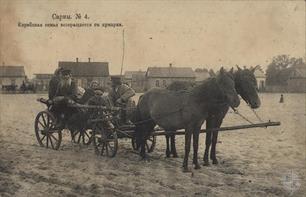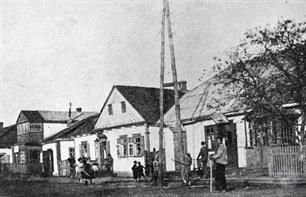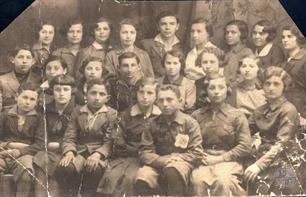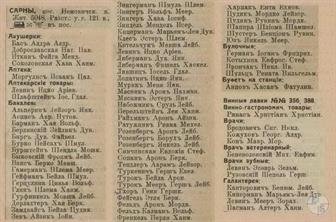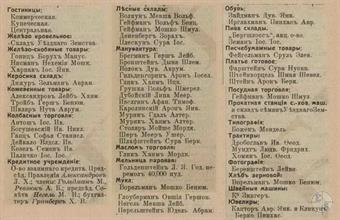Sarny
Sarny district, Rivne region
Sources:
- Jewish encyclopedia of Brockhaus & Efron
- Russian Jewish encyclopedia. Translated from Russian by Eugene Snaider
- Yad Vashem. Sarny
- The All South-Western Territory: reference and address book of the Kyiv, Podolsk and Volyn provinces. Printing house L.M. Fish and P.E. Wolfson, 1913
Photo:
- Sarny History and Ethnography Museum. Memorial sign near the ghetto entrance in Sarny
- David Shay, Wikipedia. Sarny Holocaust memorial at Holon Cemetery
- United States Holocaust Memorial Museum
- Jewish encyclopedia of Brockhaus & Efron
- Russian Jewish encyclopedia. Translated from Russian by Eugene Snaider
- Yad Vashem. Sarny
- The All South-Western Territory: reference and address book of the Kyiv, Podolsk and Volyn provinces. Printing house L.M. Fish and P.E. Wolfson, 1913
Photo:
- Sarny History and Ethnography Museum. Memorial sign near the ghetto entrance in Sarny
- David Shay, Wikipedia. Sarny Holocaust memorial at Holon Cemetery
- United States Holocaust Memorial Museum
Sarny, city (since 1939), district center in the Rivne region. It was founded at the end of the 19th century as a settlement in the Rivne district of the Volyn province. In 1919–30 - in Polessky, since 1930 - in the Volyn Voivodeship as part of Poland, in 1939–91 - as part of the Ukrainian SSR.
In 1921, 2808 Jews lived in Sarny (47.3%),
in 1931 - 3414 (44.9%),
In 1937 - 4950 Jews (45%).
In 1921, 2808 Jews lived in Sarny (47.3%),
in 1931 - 3414 (44.9%),
In 1937 - 4950 Jews (45%).
February 17, 1918 the railway station in Sarny was attacked by Gaidamaks; after the pogrom among the Jews there were killed.
In December 1918, a pogrom was arranged by troops of Directory, which lasted several days; shops and houses of Jews (especially near the railway station) were defeated.
In 1919, troops of the Volunteer Army arranged pogrom in the town, during which 350 Jews were killed.
In the 1920-30s departments of various Jewish parties and organizations acted in Sarny.
Local political organizations included cells of the Bund, the Communists, and the various Zionist parties and their youth movements (such as Dror, Beitar, Gordonia, and HaShomer Hatzair). Members of the "HeHalutz" movement were among the founders of the Zionist training facility in Klesow, and they later immigrated to the Land of Israel.
The rabbi in the 1920s was Nokhum-Jehoshua Pechnik (? –1942), in the 1930s - Moishe Gehtman (? –1942). The rabbi of the Stolin Hasids was Aron Konda.
In 1922, the department of the Jewish People’s Bank was founded, in 1925 - the Trade Industrial Bank.
Since the mid-1920s, Talmud Torah and Yeshiva operated, since 1923 - professional courses of carpenters and tailors, opened with the support of ORT.
There were several Jewish libraries, a shelter for the elderly in Sarny.
In December 1918, a pogrom was arranged by troops of Directory, which lasted several days; shops and houses of Jews (especially near the railway station) were defeated.
In 1919, troops of the Volunteer Army arranged pogrom in the town, during which 350 Jews were killed.
In the 1920-30s departments of various Jewish parties and organizations acted in Sarny.
Local political organizations included cells of the Bund, the Communists, and the various Zionist parties and their youth movements (such as Dror, Beitar, Gordonia, and HaShomer Hatzair). Members of the "HeHalutz" movement were among the founders of the Zionist training facility in Klesow, and they later immigrated to the Land of Israel.
The rabbi in the 1920s was Nokhum-Jehoshua Pechnik (? –1942), in the 1930s - Moishe Gehtman (? –1942). The rabbi of the Stolin Hasids was Aron Konda.
In 1922, the department of the Jewish People’s Bank was founded, in 1925 - the Trade Industrial Bank.
Since the mid-1920s, Talmud Torah and Yeshiva operated, since 1923 - professional courses of carpenters and tailors, opened with the support of ORT.
There were several Jewish libraries, a shelter for the elderly in Sarny.
After September 17, 1939, in the aftermath of the Molotov-Ribbentrop Pact, the Red Army entered the town, and Sarny became part of Soviet Ukraine. Under Soviet rule, Jewish communal property was confiscated, and the Jewish institutions were closed down. More than 1,000 refugees from western and central Poland, who had refused to accept Soviet citizenship, together with a few local Jews accused of "crimes against the state", were deported into the Soviet interior. An estimated 6,000 Jews lived in the town in June 1941.
The Germans entered Sarny on July 6, 1941. During the first three days after the departure of the Soviets, local Ukrainians looted the property of their Jewish neighbors. They also assaulted the Jews. Almost immediately upon their arrival, the German authorities set up a Judenrat (Jewish Council) under the last chairman of the town's organized community, S. Gershunok. However, because of Geshunok's advanced age, the Judenrat was administered de facto by its secretary, Neumann, a German-speaking refugee from Kalisz (Central Poland). A Jewish Order Service (police) was also set up, under the command of Yona Margalit.
A regime of forced labor was imposed on the Jews: The men were put to work clearing the destruction at the train depot and repairing the railway tracks that had been blown up by the retreating Red Army; the women had to clean latrines.
Initially, the Jews were ordered to wear blue-and-white armbands with an identifying Star of David. On October 1, 1941, the armbands were replaced with a circular yellow patch on the front and back of their clothes. In addition, the Jews were prohibited from leaving the town limits, and were subject to a curfew. The synagogues were seized and converted into stables and warehouses.
In the fall of 1941, the German military administration was replaced with a German civil administration, and Sarny became the administrative center of the Gebiet Sarny, which, apart from the Sarny region, also included the regions of Klesуw, W?odimierzec, Dabrowica, Rafalowka, and Rokitno. Kameradschaftsfuehrer Huala was appointed Gebietskommissar (regional commissar) of the Sarny County.
As additional Germans arrived, their demands increased. They required new quarters with fine furnishings. On October 28, 1941, the German Economic Office (Wirtschaftskommando) in Sarny issued an order to the Jews, giving them until October 31 to hand over all their livestock. In December 1941, all fur coats had to be surrendered for the use of frontline German soldiers, and in 1942 the German authorities demanded 36 kilograms of gold from the Jewish population.
Around Passover, in early April 1942, a ghetto was established in Sarny. The area was surrounded with barbed wire, and Ukrainian guards were posted around it. That same month, Jews from the outlying villages of Niemowicze, Czudel, G?uszyca, Horodec, Antonуwka, Bielatycze, Lubikowicze, Cepcewicze, Strzelsk, and Luchcze were forcibly resettled in the ghetto. Some Roma people (about 200-300 in total) were also moved there. There was a separate ghetto for artisans and their families, and it was liquidated together with the main ghetto.
In June 1942, when the ghetto inmates received reports about the mass murders in the region, three resistance groups were formed, with the assistance of the head of the Judenrat. One of the units was headed by Yona Margalit. The groups were able to procure small quantities of firearms and other assorted weapons, as well as flammable materials. They planned to blow up the power station, set fire to the ghetto when it was about to be liquidated, break through its fences, attack the guards, and create confusion, to enable the inmates to flee into the nearby forests. But Neumann, the secretary of the Judenrat, threatened them with arrest and prevented them from taking any action.
On August 25, 1942, the Nazi authorities summoned the Judenrat and demanded a third "assessment'' of 7 gold rubles per person. The inmates, who had no way to raise this sum, had to surrender the gold in their teeth to fulfill the quota.
On August 26, 1942, the inmates were taken from the ghetto to the Poleska camp, which was already inhabited by Jews from the nearby localities of D?browica, Rokitno, Klesуw, Bere?nica, and Tomaszgorod (approximately 14,000 people in total). On August 27-28, the Germans began to take the inmates of the Poleska camp to the nearby forest to be shot. Members of the resistance groups cut through the barbed wire surrounding the camp and urged the Jews to escape. Several barracks in the camp area were torched, with people still inside. Thousands of inmates tried to flee, but many were shot while crossing the fences and in the streets of the town. The remaining Jews were shot by various German units in the Poleska camp forest near Sarny.
Of those Jews who had managed to escape from the ghetto before and during the murder operation, many were captured in hiding and killed by the Ukrainian and German police shortly thereafter. Some of them were murdered in the town's Jewish cemetery.
The Germans entered Sarny on July 6, 1941. During the first three days after the departure of the Soviets, local Ukrainians looted the property of their Jewish neighbors. They also assaulted the Jews. Almost immediately upon their arrival, the German authorities set up a Judenrat (Jewish Council) under the last chairman of the town's organized community, S. Gershunok. However, because of Geshunok's advanced age, the Judenrat was administered de facto by its secretary, Neumann, a German-speaking refugee from Kalisz (Central Poland). A Jewish Order Service (police) was also set up, under the command of Yona Margalit.
A regime of forced labor was imposed on the Jews: The men were put to work clearing the destruction at the train depot and repairing the railway tracks that had been blown up by the retreating Red Army; the women had to clean latrines.
Initially, the Jews were ordered to wear blue-and-white armbands with an identifying Star of David. On October 1, 1941, the armbands were replaced with a circular yellow patch on the front and back of their clothes. In addition, the Jews were prohibited from leaving the town limits, and were subject to a curfew. The synagogues were seized and converted into stables and warehouses.
In the fall of 1941, the German military administration was replaced with a German civil administration, and Sarny became the administrative center of the Gebiet Sarny, which, apart from the Sarny region, also included the regions of Klesуw, W?odimierzec, Dabrowica, Rafalowka, and Rokitno. Kameradschaftsfuehrer Huala was appointed Gebietskommissar (regional commissar) of the Sarny County.
As additional Germans arrived, their demands increased. They required new quarters with fine furnishings. On October 28, 1941, the German Economic Office (Wirtschaftskommando) in Sarny issued an order to the Jews, giving them until October 31 to hand over all their livestock. In December 1941, all fur coats had to be surrendered for the use of frontline German soldiers, and in 1942 the German authorities demanded 36 kilograms of gold from the Jewish population.
Around Passover, in early April 1942, a ghetto was established in Sarny. The area was surrounded with barbed wire, and Ukrainian guards were posted around it. That same month, Jews from the outlying villages of Niemowicze, Czudel, G?uszyca, Horodec, Antonуwka, Bielatycze, Lubikowicze, Cepcewicze, Strzelsk, and Luchcze were forcibly resettled in the ghetto. Some Roma people (about 200-300 in total) were also moved there. There was a separate ghetto for artisans and their families, and it was liquidated together with the main ghetto.
In June 1942, when the ghetto inmates received reports about the mass murders in the region, three resistance groups were formed, with the assistance of the head of the Judenrat. One of the units was headed by Yona Margalit. The groups were able to procure small quantities of firearms and other assorted weapons, as well as flammable materials. They planned to blow up the power station, set fire to the ghetto when it was about to be liquidated, break through its fences, attack the guards, and create confusion, to enable the inmates to flee into the nearby forests. But Neumann, the secretary of the Judenrat, threatened them with arrest and prevented them from taking any action.
On August 25, 1942, the Nazi authorities summoned the Judenrat and demanded a third "assessment'' of 7 gold rubles per person. The inmates, who had no way to raise this sum, had to surrender the gold in their teeth to fulfill the quota.
On August 26, 1942, the inmates were taken from the ghetto to the Poleska camp, which was already inhabited by Jews from the nearby localities of D?browica, Rokitno, Klesуw, Bere?nica, and Tomaszgorod (approximately 14,000 people in total). On August 27-28, the Germans began to take the inmates of the Poleska camp to the nearby forest to be shot. Members of the resistance groups cut through the barbed wire surrounding the camp and urged the Jews to escape. Several barracks in the camp area were torched, with people still inside. Thousands of inmates tried to flee, but many were shot while crossing the fences and in the streets of the town. The remaining Jews were shot by various German units in the Poleska camp forest near Sarny.
Of those Jews who had managed to escape from the ghetto before and during the murder operation, many were captured in hiding and killed by the Ukrainian and German police shortly thereafter. Some of them were murdered in the town's Jewish cemetery.
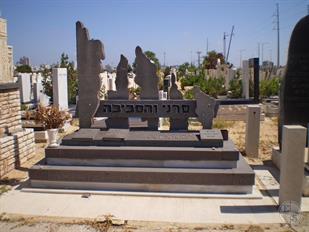 |
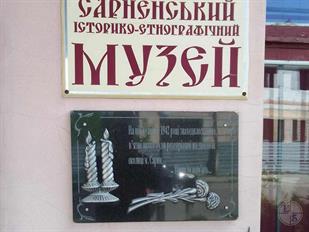 |
| Sarny holocaust memorial at Holon Cemetery, 2009 | Memorial sign near the ghetto entrance in Sarny, 2024 |
Jews were officially permitted to settle in Sarny in 1903, after the town had become an important railway hub. This permission was given by a ministerial decree issued by the Imperial Russian authorities.
At the beginning of the 20th century, Jews opened shops and shops near the railway stations.
In 1907, Boaz Yoshpe founded a private school with teaching in Hebrew.
In 1914, the Jews owned the only pharmacy (Isaak Morgulis), both pharmacy warehouses, the only kerosene warehouse, all 5 forest warehouses, the only mill (L.Goldenshtrin), the only printing house (Mendl Bozhek) and more than 90 shops (including 55 bachelories, 14 manufactory).
The Jews were both dentists, both jewelers, 2 of 4 midwives.
Jewish Credit Society acted.
There were the Zionist circle, the Jewish library in Sarny.
In 1917, a Jewish school opened (since 1920 - the school of the Tarbut network) and an orphanage.
In 1903–18, Matias Kabachnik (1877–1918) was a rabbi.
Of the 5 synagogues in the town 3 were Hasidic.
At the beginning of the 20th century, Jews opened shops and shops near the railway stations.
In 1907, Boaz Yoshpe founded a private school with teaching in Hebrew.
In 1914, the Jews owned the only pharmacy (Isaak Morgulis), both pharmacy warehouses, the only kerosene warehouse, all 5 forest warehouses, the only mill (L.Goldenshtrin), the only printing house (Mendl Bozhek) and more than 90 shops (including 55 bachelories, 14 manufactory).
The Jews were both dentists, both jewelers, 2 of 4 midwives.
Jewish Credit Society acted.
There were the Zionist circle, the Jewish library in Sarny.
In 1917, a Jewish school opened (since 1920 - the school of the Tarbut network) and an orphanage.
In 1903–18, Matias Kabachnik (1877–1918) was a rabbi.
Of the 5 synagogues in the town 3 were Hasidic.

- Home
- Shtetls
- Vinnytsia region
- Volyn region
- Dnipro region
- Donetsk region
- Zhytomyr region
- Zakarpattia region
- Zaporizhzhia region
- Ivano-Frankivsk region
- Kyiv region
- Kropyvnytskyi region
- Luhansk region
- Lviv region
- Mykolayiv region
- Odessa region
- Poltava region
- Rivne region
- Sumy region
- Ternopil region
- Kharkiv region
- Kherson region
- Khmelnytskyi region
- Chernihiv region
- Chernivtsi region
- Cherkasy region
- Crimea
- Synagogues
- Cemeteries
- Objects & guides
- Old photos
- History
- Contact
Jewish towns of Ukraine
My shtetl
My shtetl
Donate
Jewish towns of Ukraine
